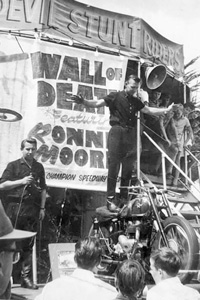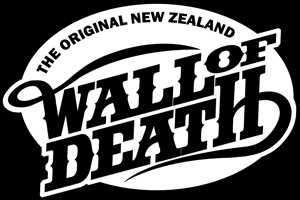History of the New Zealand Wall of Death.
Before the Wall — The Pioneers
The Staig Troupe.
Our narrative begins with the Staig Troupe, a vaudeville steeplejack cycling act from Watford, England, who had been playing to tremendous acclaim at the London Hippodrome.
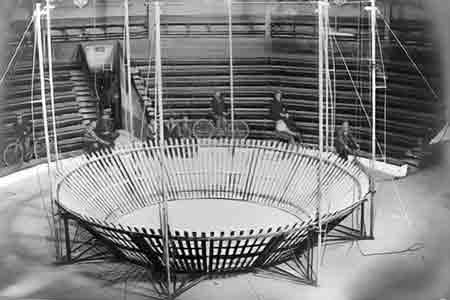
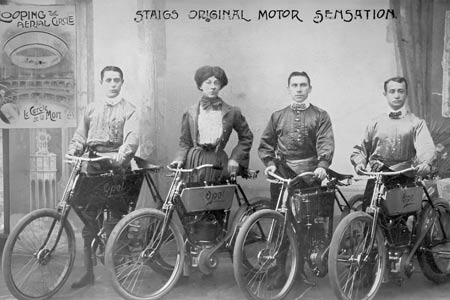
When Australian producer James Brennan saw them, he realised their unique entertainment value and signed them to tour Australia, with their first performance in November 1910 at Sydney's National Ampitheatre, again to outstanding acclaim.
After successfully completing their tour of Australia, they crossed the Tasman and began touring New Zealand's numerous Circuses and Shows with their bicycle and motorbike performances in May 1911.
The "Whirl of Death" was the opening act for the Staigs. It was the size of a giant tea cup, standing 4.5 metres (15 feet) tall with a top diameter of 5.5 metres (18 feet).
The cage had a bottom diameter of 2.4 metres (8 feet) and a width of around 1.5 metres (5 feet) from the floor, where the sides were perpendicular.
Beginning at the bottom of the cup, the performers rode the sides at high speeds, generating enough momentum to ride at right angles to the perpendicular wall on a variety of bicycles, motor bicycles, and motorbikes.
Arthur Stone (Wizard Stone, Aviator Stone) was travelling with Wirth Bro's Australian Circus with his bicycle act when the Staigs bought a 5.5-meter (18-foot) "Globe of Death" from him.
They made their New Zealand debut with it in October 1915 at the Baker Bro's Circus in Hastings.
Because of its spherical steel latticework frame, spectators could readily watch the surreal activities (defying gravity) taking place inside the Globe of Death from any angle.
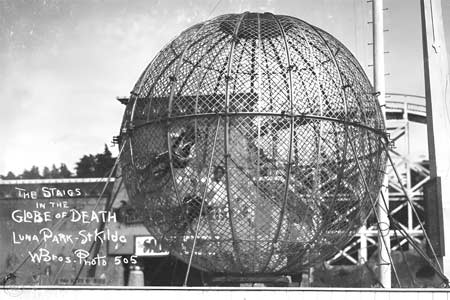
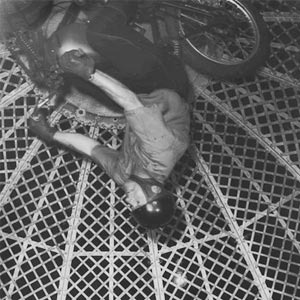
The Wall of Death
Staig Enterprises
The Staig's subsequent new act was a "Silo Drome" with dimensions of 5.5 meters (18 feet) by 9 meters (30 feet) in diameter, which was constructed in the United States.
They acquired the rights to the act from American stunt rider Ernest Ibsch (Fearless Jackson, Jack Jackson), who was touring Australia with his own wall known as the "Whirl of Death."
On September 20, 1928, The Staigs gave The Silo Drome its debut ride in New Zealand at the Wellington Winter Show. The Staigs wall was purpose-built in Coney Island, New York, constructed of strong Oregon Pine and weighed approximately 5.5 tonnes (6 tons). It took several months to complete.
When not travelling the country, the Silo Drome and the Globe of Death were stationed in Auckland's "Luna Park." The Silo Drome was dubbed "The Wall of Death" shortly after it launched in the 1929 season.
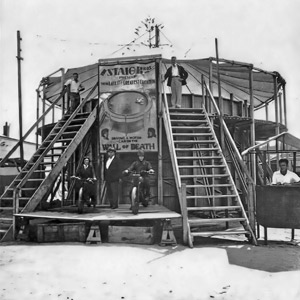
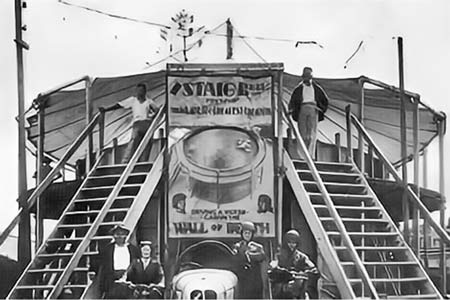
Laurence Staig added driving a supercharged Baby Austin racing motorcar to the Wall of Death Act in February 1932 at the Masterton Showgrounds.
Unfortunately, the Great Depression had begun in the 1930s and was having an unavoidable negative influence. As a result, the show business sector came to a halt, with the final performance taking place in October 1935 at the Hastings Royal Show in Hawkes Bay.
International Girl Riders Team
The next Wall of Death Show took place during the New Zealand Centennial Exhibition in Wellington, which ran from November 1939 to May 1940. Greenhalgh and Jackson (Australia's leading sideshow organizers) brought the Act and numerous other performers over from Australia.
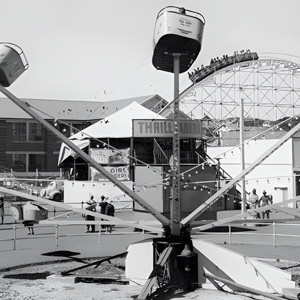
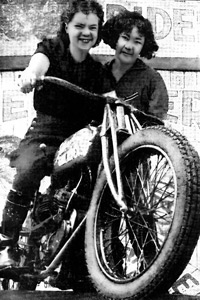
This Wall of Death stood 4.9 metres (16 feet) tall and 8.5 metres (28 feet) broad. The International Girl Riders Team consisted of American Pat Gamble and Moy Wong from China, and also included Canadian male rider Edmund Du Barrie (Victor du Barry).
The Moorharts
Les Moore, who was born in Hobart, Tasmania, got inspired in February 1939 while watching the International Girl Riders Team perform on the Wall of Death at Tasmania's Royal Hobart Showgrounds.
He created his own temporary training Wall in the backyard and learned to ride it via trial and error.
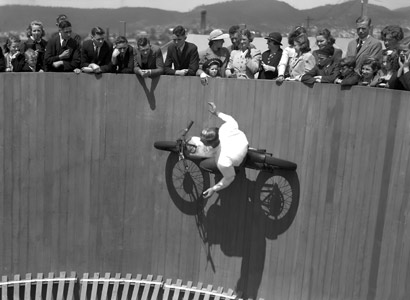
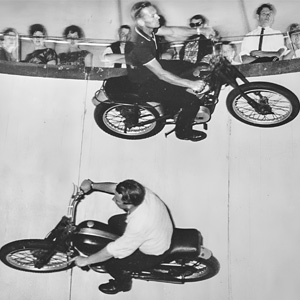
Despite being shallow and difficult to ride, the improvised structure drew other motorbike riders from all around the State.
Moore recalls the passionate amateurs frequently crashed and unwittingly gave the circular track such a beating that it turned egg-shaped.
Les soon built a 3.6-meter (12-foot) high and 9-meter (30-foot) wide Wall and developed his own Wall of Death Act, with riding partner Lionel Hart, known as the Moorharts.
In March 1943, Les and Lionel staged their first public performance during the Royal Hobart Regatta in Tasmania.
Ronnie, his ten year old son, was learning to ride pillion with Les and also how to ride the bally, or stationary rollers. "Bally" is an old sideshow term meaning a free show, used to draw customers into the main attraction.
Post War — The Wall of Death
The Moorson's
Les and Ronnie, then 12 years old, performed as the Moorson's for the first time on November 13th, 1945, at the Devonport Show in Tamania, with his mother Clarice collecting the threepence admission charge.
The act was a great success because of the tenacious boy's trickbook on the stationary rollers and his stunt riding pillion with Les.
They were quickly asked to tour other Australian shows due to their overwhelming popularity.
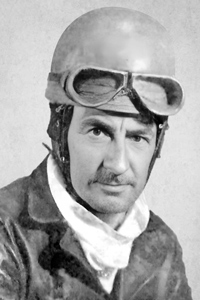
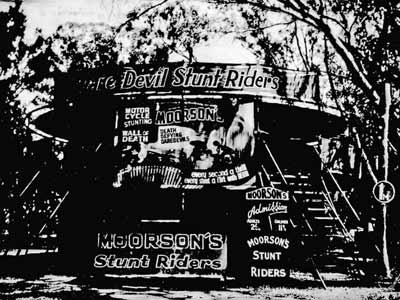
At the Benalla Show held in Victoria on October 18th, 1946, Les spiced things up by developing an outrageous act with two riders — himself and Lionel Hart — riding in opposite directions at the same time, just missing each other by centimeters every lap.
Unfortunately, Les's tyre blew out at the Camperdown Show in Melbourne, Victoria, on November 25th, 1946. This resulted in a disastrous head-on (their second) collision, effectively putting Les's partner out of business.
Greenhalgh & Jackson approached the Moorsons to ride The Great Whirl of Death after rider Victor du Barry fractured his pelvis on stage in Queensland.
In June 1947, they appeared at the Maryborough Show, Rockhampton Show, Mackay Show and the Charters Towers Show alongside the Reckless Jacksons (Ernest Ibsch) and International Girl Rider, Pat Gamble.
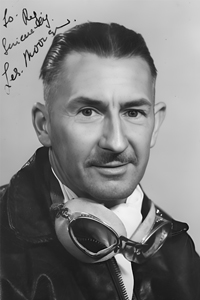
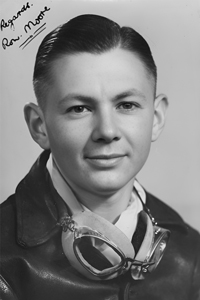
Following this was the Cairns Show in July 1947, and the audience was astounded to see The Moorsons riding in the opposite direction (clockwise) compared to all the other straight wall riders.
They finished their Queensland contract with Greenhalgh & Jackson in August 1947, when they got to ride with the sensational Dare Sisters at the Brisbane Exhibition.
Following a performance at the Perth Royal Show in October 1947, the family was immediately offered a personal contract to tour either South Africa or New Zealand, by Lance Skuthorpe.
Les chose New Zealand, and after completing a whirlwind six-month tour of the North and South Islands with Skuthorpe's Rodeo and Circus, the family chose to settle in Christchurch in 1948.
The Mahon Bros.
Even with full-time work available, Huntly coal miner Roy Mahon quickly understood he would not make much progress in life working with coal.

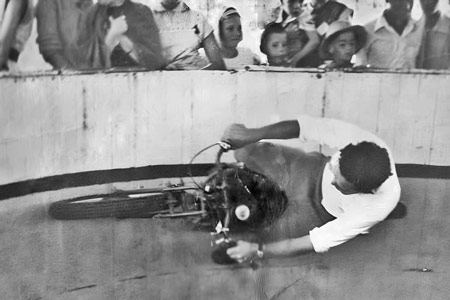
He managed to obtain a 6.1-meter (20-foot) tall and 7.6-meter (25-foot) wide Wall of Death. He taught himself how to ride it, and perform with his brother "Huck" (a pseudonym for other riders) in the weekends.
It wasn't long before they debuted as the Mahon Bro's, the "Hell Riders". Their first official Wall of Death performance was at the Northland Exhibition, held in June 1947 at Whangarei.
This Wall was infamous for being difficult to ride, and accidents were common. After Huck was seriously injured and out of commision for eight months, the decision was taken to replace the Wall with Les Moore's "Short Wall", a 3.6-meter (12-foot) high and 9-meter (30-foot) wide Wall of Death. This was originally used on June 29, 1949, at the Whangarei Big Winter Exhibition.
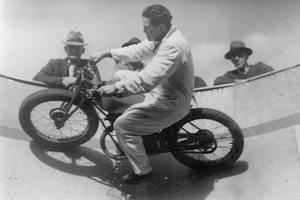
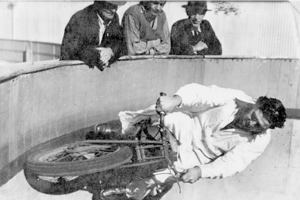
Roy employed many casual riders before meeting Graham Pickup in 1955. Graham had a natural riding ability and was rapidly schooled to ride the Wall of Death, he also had the gift of gab, making him an outstanding showman.
Just like working with coal, Roy rapidly realised that operating the Wall of Death, with its limited Summer season, transportation costs, risk of injury, and continuous upkeep, it was not going to yield a lot of money. It made more sense to grow and supplement the business with small carnival rides that could be easily operated longer throughout the year.
Roy founded Electric Speedway Limited (ESL) in 1961 to run a business focused on providing carnival rides, sideshows, and other entertainment at events such as the Agricultural and Pastoral Society fairs held around New Zealand's North Island.
Mahons Amusements Limited (MAL) was founded in 1990 to take over ESL's business and is still in operation today, with Roy's grandsons in charge.

